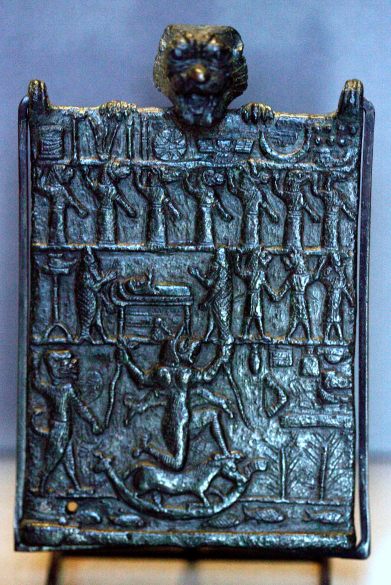This month, let’s talk about old fear. Ancient Mesopotamian religion kicked off as much as 6 thousand years ago, but the spirits of its deities can still be recognized today: Tammuz, god of food and vegetation; Dagon, god of fertility; Enlil, god of breath. All were thought to be like humans, but immortal, shining so bright that they could not be looked at. They were not mystical beings, but masters that humanity should obey and fear. Most of them were good, or at least chaotic-neutral. One of them was not.
Lamashtu was a deity that destroyed lives. She did it not because she had to, but because she wanted to. She was distinct in that way from her peers, who might be destructive, but were so under obligation, or with some purpose other than destruction for destruction’s sake. Lamashtu personified a fear as old as the human race: fear of losing a newborn. She took the already bloody, dangerous process of delivery and made it that much worse.
Known for her signature move of ripping babies from breasts to slurp their blood and gnaw on their bones, Lamashtu appeared as a mythological hybrid with a hairy body, a lioness’s head, donkey’s teeth and ears, a set of long fingers and fingernails, and sharp bird talon feet (what is it with female monsters and taloned feet, anyway?). She was often depicted standing on a donkey, simultaneously gripping snakes and nursing a pig and a dog. When not terrorizing the living, she traversed the underworld in a boat. Her name meant “she who erases.”

Lamashtu’s name in cuneiform, courtesy of Wikimedia Commons. The style her name was written in signaled her power and deity status.
Beyond kidnapping, Lamashtu’s rap sheet included (but was not limited to):
- Killing children
- Killing unborns
- Killing infants
- Torturing/attacking mothers and expectant mothers
- Eating men and drinking their blood
- Disturbing sleep
- Bringing nightmares
- Killing foliage
- Infesting rivers and lakes
- Bringing a lot of disease/sickness
- Bringing death

The plaque in question, courtesy of Wikimedia Commons. Lamashtu appears at the bottom center. Pazuzu is the dude to her left, as well as the guy grinning over the whole scene like a Disney villain over the front of a 90’s VHS tape.
Understandably, the Mesopotamians were terrified of Lamashtu and did everything they could to discourage her visits. Expectant mothers wore amulets with the sign of Pazuzu, Lamashtu’s husband/rival who was not super great in his own right (he tended to bring famine and drought), but was the only person who might get her to stop. Amulets are hardly the only protective artifacts we’ve found, however. Especially in the first millennium, anti-Lamashtu paraphernalia was everywhere. Fun tip: there is (or was recently) an actual Lamashtu exorcism plaque on display at the Louvre (field trip, anyone?). It depicts the exorcism scene with Pazuzu watching. The patient reaches out in pain; priests in the fishskins of the god Ea crowd around him. Lamashtu appears large and terrible at the bottom, barely held back by Pazuzu. The inscription describes her as “furious and cruel, a dazzling goddess; she is a she-wolf; she snatches the young man on the path, the girl at play, the child from the arms of his nurse.”
I’ll leave you today with an ancient Mesopotamian ritual and incantation against Lamashtu-induced illness. Those of you who fear for your family’s safety–or who see long, strange fingers peeking around your doorframe when you’re lying sick in bed–perhaps will find the information useful. The ritual goes as follows:
- Procure a Lamashtu figurine. (This is stumbling block #1. Good luck.)
- Place a sacrifice of bread before the figurine, and pour water over it.
- Put the figurine on the back of a black dog.
- Have the black dog carry the figurine to be placed at the head of the sick person for three days.
- Stuff a piglet’s heart in the figurine’s mouth, and leave it there for the duration of those three days.
- Offer further food sacrifices, and recite your incantation thrice daily:
Great is the daughter of Heaven who tortures babies
Her hand is a net, her embrace is death
She is cruel, raging, angry, predatory
A runner, a thief is the daughter of Heaven
She touches the bellies of women in labor
She pulls out the pregnant women’s baby
The daughter of Heaven is one of the Gods, her brothers
With no child of her own.
Her head is a lion’s head
Her body is a donkey’s body
She roars like a lion
She constantly howls like a demon-dog.
7. At dusk on the third day, take the figurine outside and bury it near the wall.
Easy-peasy, right? At least the stakes aren’t life or dea–oh, wait. Yes they are.
I’ll leave you to it.
How many dead houseplants and brutal sinus infections can you blame on Lamashtu? Share your story in the comments below.
Featured image by Chris Rhoads.





0 Comments
Trackbacks/Pingbacks